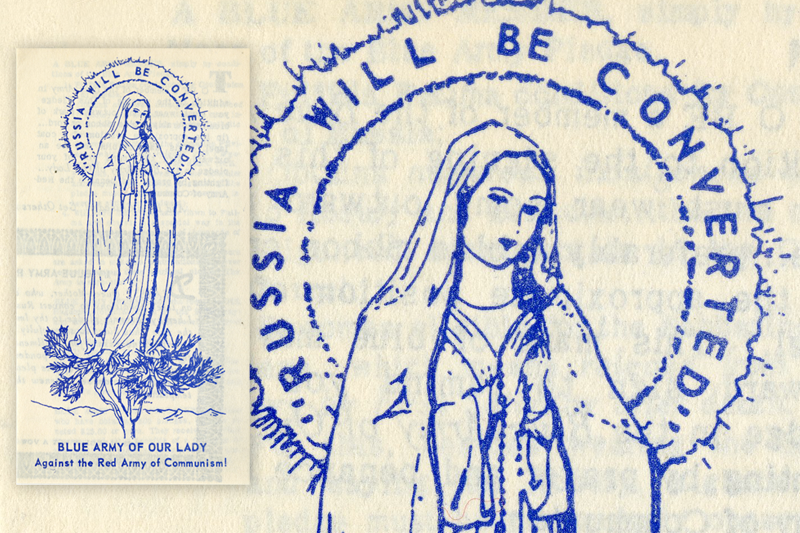Blogs

Blue Army: Joining the Ranks of Our Lady
By Michele Jennings
In a leaflet from the Marian Library, Our Lady of Fátima is printed in vivid azure ink on a white page. She stands with hands clasped around a rosary on a holm oak tree, the same species that she appeared under in 1917 to three children in central Portugal. This staid and classic depiction of Mary is surrounded by a halo bearing the message “Russia will be converted.”
What do the apparitions in Portugal have to do with Russia? An inscription right beneath the oak tree and the craggy Portuguese landscape offers a clue: “Blue Army of Our Lady Against the Red Army of Communism!”
In May 1917, three children ranging in age from 7 to 10 — Lúcia dos Santos and her cousins, Francisco and Jacinta Marto — reported the first of several sightings of Mary in an area near their home in Fátima called Cova de Iria (Cove of St. Irene). The apparitions culminated with a final vision on Oct. 13, 1917, known as “the day the sun danced.” A reported 70,000 to 100,000 faithful descended on Cova de Iria for the final apparition, an event that highlighted growing political tensions in Portugal, especially between Catholics and the anticlerical First Portuguese Republic. Over a decade later, longstanding Portuguese dictator Antonio de Oliveira Salazar used the story of Fátima to drum up nationalistic sentiment and combat fears over the spread of communism in Portugal in light of the neighboring Spanish Civil War.
Lúcia, the only witness to the apparition who survived to adulthood, joined the Carmelite order and wrote an account of the apparition from her seclusion in 1941. In it, she detailed two out of three secrets the Virgin had relayed to the children, saving the last secret in a sealed envelope that was opened in 1960. The first secret detailed a vision of hell to compel the children to pray the rosary, while the second was an appeal for Russia’s conversion. Lúcia revealed the third secret in a letter to Pope Pius XII in 1944, which Father C.C. Martindale, S.J., summarized thusly in his 1950 book The Meaning of Fátima:
If you do what I tell you, many souls will be saved and there will be peace. The war [World War I] is about to end, but if men do not cease to offend God there will begin a worse one in the Pontificate of Pius XI. … If my demands are listened to, Russia will be converted and there will be peace. Otherwise, Russia will spread her errors throughout the world arousing wars and persecutions of the Church. Many good men will be martyred; the Holy Father will have much to suffer; and various nations will be annihilated (quoted in O’Connor, 7-8).
In 1946, the head of the Scapular Apostolate, American John Haffert, traveled to Portugal to meet with Lúcia, and the origins of the Blue Army came into focus. Joining forces with Monsignor Harold Colgan in 1947, the two worked to found the Blue Army and bring the International Pilgrim Virgin Statue of Fátima on a tour of the United States. Millions of American Catholics honored the Pilgrim Virgin and prayed for the conversion of Russia. Devotion to Fátima in the United States took off during the Cold War and made anticommunist sentiment a mainstream aspect of American life as well as American Catholic religious and political practice. This included pop culture, such as the popular song “Our Lady of Fátima,” originally performed by Gladys Gollahon and eventually covered by jazz singer Tony Bennett.
In the late 1940s and ’50s, this popularity extended to membership in the Blue Army, also known as the World Apostolate of Fátima. By 1952, membership had reached 2 million, and members could join using a leaflet like the one featured in this piece. Inside, it provides details about the Blue Army, including its pledge and a mail-in membership form. It carries the following instructions:
To be a member of the Blue Army in addition to the signing of this Pledge you must wear some outward mark of blue…preferably a blue ribbon or cord…(in the approximate position of a coat lapel.) This mark of blue may be an outward sign to remind you of your pledge in the Blue Army of Our Lady…fighting by prayer and penance the Red Army of Communism.
Read More
O’Connor, David L. “‘Russia will be converted’: The Blue Army of Our Lady of Fátima in Cold War America.” American Catholic Studies, vol. 133, no. 2, June 2022, pp. 1–32, https://doi.org/10.1353/acs.2022.0016.
Martindale, C. C. The Meaning of Fátima. New York: Kenedy, 1950.
— Michele Jennings is a visiting librarian and archivist in the Marian Library.
